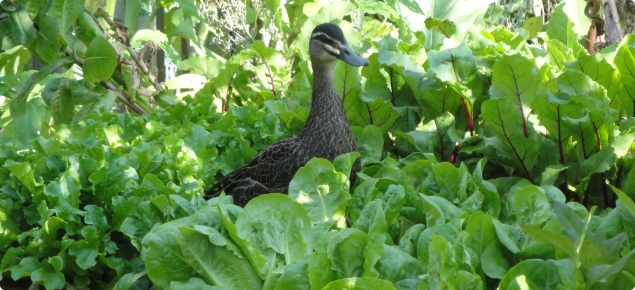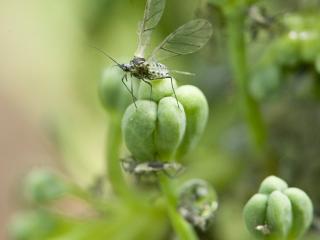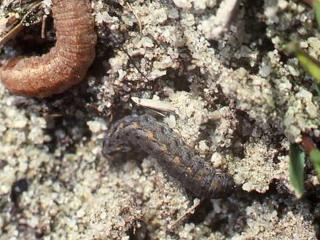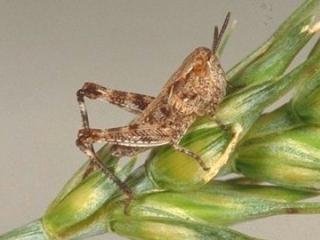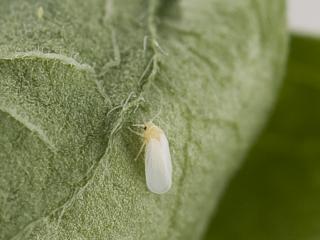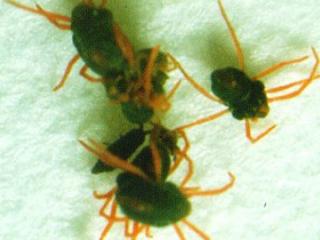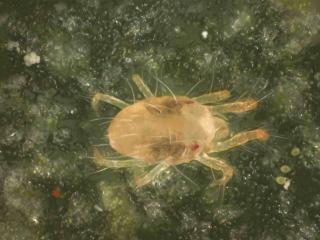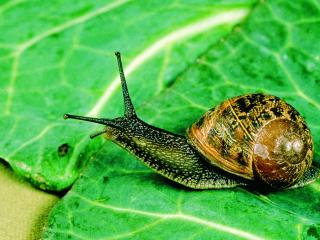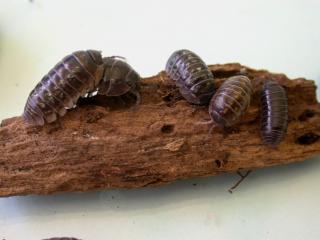Insects
Aphids
Aphids are 1–3mm, soft-bodied insects that can be green, grey, or black. Most commonly seen in spring and autumn, aphids can be winged or wingless and are usually slow-moving. Aphids cluster on the tips of the shoots, sucking the sap from the plant, which reduces plant vigour. Aphids can also spread viruses which can severely reduce yields and quality.
A number of natural enemies such as lacewings and ladybugs will give some biological control. If required, control with sprays such as garlic extract or horticultural oils and horticultural soaps. Sprays containing pyrethrum and piperonyl butoxide can also be used but crops can not be picked for one day after its use.
Caterpillars
Caterpillars are usually the larval stages of moths or butterflies. They are normally hairless, with a long cylindrical body from 10–50mm long and range in colour. Caterpillars may attack leaves, stems, flowers, fruits and roots.
Green caterpillars of the large cabbage white butterfly and the small diamond-back (cabbage) moth can severely damage the leaves of the Brassica family which includes broccoli, cabbage, kale and cauliflower.
Cluster caterpillars, woolly bear caterpillars and looper caterpillars will attack the leaves of most vegetables.
The eggfruit caterpillar bores into aubergine and the native budworm will bore into the fruit of many vegetables, especially, capsicums, tomatoes and sweet corn. These fruit pests are hard to kill and early spraying is required to kill the caterpillars before they enter the fruits.
Other caterpillars attack the roots and stems. Potato moth caterpillars will ‘mine’ potato leaves and bore into potato tubers.
Cutworms
Cutworms hide in the soil by day and attack plants at night. They damage the stem of young seedlings at the base, causing the plant to collapse.
Control with Bacillus thuringiensis, a biological insecticide which targets only caterpillars but needs to be sprayed every five days or after rain or overhead watering.
Spinosad is a chemical of low toxicity which has a translaminar movement, which means the chemical moves into the leaf, making the active ingredient resistant to rain and sunlight once the spray has dried. Sprays containing pyrethrum and piperonyl butoxide can also be used but crops can not be picked for one day after spraying.
Grasshoppers and locusts
In some years, grasshoppers and locusts can appear in plagues in summer and are capable of destroying all plants.
They are very hard to control as they are unlikely to eat baits until all the green vegetation is eaten. Use baits containing carbaryl.
Thrips
Thrips are 1–2mm long torpedo-shaped insects that can be yellow, green, grey, or black. Thrips suck the sap of leaves, fruit and flowers and this feeding results in white streaks on the plants.
Some species are carriers of tomato spotted wilt virus. Control with garlic extract, horticultural soaps or sprays containing pyrethrum and piperonyl butoxide.
Weevils
A few species of weevils are pests, such as the garden and vegetable weevils.
At night the 10mm adults may attack stems and leaves of asparagus, beetroot, carrots, parsnips, peas, potatoes, rhubarb, silverbeet and spinach are also subject to attack. The 12mm larvae may bore into the tubers of carrots, potatoes and sweet potatoes.
Plants are more suseptible when water stressed.
To reduce numbers wrap Dacron quilt wadding around the base of plants. The legs of the weevils get caught in the wadding. An alternative is to put aluminum foil or horticultural glue around the stems of plants. Weevils pupate in the soil and both these methods traps adult weevils moving up into the foliage, which interrupts the breeding cycle.
Whiteflies
Whiteflies are tiny, 1.5–2.0mm, sap-sucking insects that can damage vegetables grown in the open and in greenhouses.
Damage is worst in spring and autumn. The adults resemble small moths and fly in large numbers when disturbed. The young stages have no wings and look more like scale insects. Insects like lace-wings, ladybirds and hoverflies will feed on whiteflies.
Whiteflies can be difficult to control using pesticides. Control with sprays such as garlic extract or sprays containing pyrethrum and piperonyl butoxide. Horticultural soaps and soapy water may also reduce numbers.
Mites
Mites have eight legs compared to insects (which have six legs) and at less than 1mm in size are much smaller than most insects. Mites are sap-suckers and damage can range from stippling on the leaves of the plant, to bronzing of the stems and leaves.
They are most active in dry weather and sprays of water beneath the leaves will reduce numbers. Control with horticultural soap which should be sprayed beneath the foliage at the first sign of the mites.
At night, the 10mm adults may attack stems and leaves of asparagus, beetroot, carrots, parsnips, peas, potatoes, rhubarb and silverbeet.
Tomato russet mite on tomatoes
Most people are unaware of this pest because it cannot be seen with the naked eye. A lens which magnifies 20 times is needed to recognise these mites.
In summer, the damage they cause is easily identified. The stems of the plant become bronzed, the lower leaves wither and die and the skin of the fruit becomes leathery.
Two-spotted mite or red spider mite
A serious summer pest of most crops, two-spotted mites are usually first noticed by the yellow stippling of the leaves, which look russetty and dry.
The undersides of the affected leaves usually have fine webs, under which there are hundreds of small yellow to red mites about 1–2mm long and pearly eggs. The mites suck the sap of the leaves.
Other pests
Snails and slugs
These molluscs can attack most crops and chew holes in leaves and kill seedlings. They are most active at night, especially in moist weather. Control is especially important in April and May when the adults lay eggs.
Slaters, snails and slugs may be controlled with baits that contain methiocarb or metaldehyde. A copper silicate spray used on plants will repel the pests. Do not expose baits to children or pets.
For further information, including a recipe for organic baits, refer to the article snail and slug control.
Slaters
Slaters or woodlice are small crustaceans that hide in damp situations in the garden. Slaters feed on organic matter, but at high densities they can damage new seedlings and ripe fruit such as melons, strawberries and the roots of pot plants.
Unfamiliar pests
The Department of Agriculture and Food, Western Australia (DAFWA) is on the lookout for animal and plant pests, diseases and weeds that could pose a threat to agriculture and the environment.
If you discover something unfamiliar, please send a photo to the Pest and Disease Information Service (PaDIS) by email: info@agric.wa.gov.au or phone them on Freecall: 1800 084 881.
Please read the sending samples for identification web article before sending, or bringing in, samples to the Pest and Disease Information Service, 3 Baron-Hay Court, South Perth, 6151, WA.

